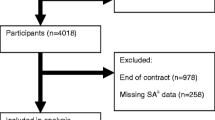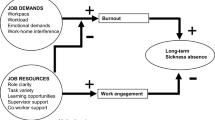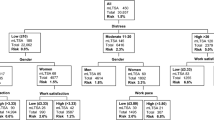Abstract
Objectives
To investigate the Maslach Burnout Inventory—General Survey (MBI—GS) and the Utrecht Work Engagement Scale (UWES) for their ability to identify non-sicklisted employees at increased risk of long-term sickness absence (LTSA).
Methods
One-year prospective cohort study including 4,921 employees participating in occupational health surveys in the period 2008–2010. The MBI—GS and UWES were part of the health survey questionnaire and LTSA in the year following the health survey was retrieved from an occupational health register. Associations of baseline MBI—GS and UWES scores with LTSA during 1-year follow-up were stratified by the cause (mental, musculoskeletal, and other somatic illness) of LTSA. Discrimination was assessed by the area (AUC) under the receiver operating characteristic curve and considered practically useful for AUC ≥0.75.
Results
During 1-year follow-up, 103 employees (2 %) had LTSA due to mental (N = 43), musculoskeletal (N = 31), or other somatic (N = 29) illness. MBI—GS scores were positively and UWES scores negatively associated with mental LTSA, but not musculoskeletal or other somatic LTSA. Discrimination between employees at high and low risk of mental LTSA was moderate: AUC = 0.68 for the MBI—GS and AUC = 0.70 for the UWES. Discrimination did not improve when the MBI—GS and UWES were used simultaneously.
Conclusion
The MBI—GS and UWES predicted future mental LTSA in non-sicklisted employees, but discrimination was not practically useful for identifying employees at high risk of LTSA. However, both instruments could be used to select employees for further assessment of mental LTSA risk.

Similar content being viewed by others
References
Ahola K, Kivimäki M, Honkonen T, Virtanen M, Koskinen S, Vahtera J, Lönnqvist J (2008) Occupational burnout and medically certified sickness absence: a population-based study of Finnish employees. J Psychosom Res 64:185–193
Bakker AB, Demerouti E, Schaufeli WB (2002) Validation of the Maslach Burnout Inventory—general survey: an internet study. Anxiety Stress Coping 15:245–260
Bakker AB, Demerouti E, de Boer E, Schaufeli WB (2003) Job demands and job resources as predictors of absence duration and frequency. J Vocat Behav 62:341–356
Baumann AE (2007) Stigmatization, social distance and exclusion because of mental illness: the individual with mental illness as a ‘stranger’. Int Rev Psychiatry 19:131–135
Borritz M, Rugulies R, Christensen KB, Villadsen E, Kristensen TS (2006) Burnout as a predictor of self-reported sickness absence among human service workers: prospective findings from three year follow up of the PUMA study. Occup Environ Med 63:98–106
De Graaf R, Tuithof M, van Dorsselaer S, ten Have M (2011) Sickness absence due to mental and somatic disorders among employed. Results of the Netherlands Mental Health Survey and Incidence Study-2 (NEMESIS-2). Trimbos Institute, Utrecht (in Dutch)
Demerouti E, Mosterd K, Bakker AB (2010) Burnout and work engagement: a thorough investigation of the independency of both constructs. J Occup Health Psychol 15:209–222
European Commission (2006) Mental Well-being. Special Eurobarometer 248/Wave 64.4. http://ec.europa.eu/health/ph_information/documents/ebs_248_en.pdf. Accessed 22 Mar 2014
Fad J, Upadhye S, Worster A (2006) Understanding receiver operating characteristic (ROC) curves. CJEM 8:19–20
Gaebel W, Zäske H, Baumann AE (2006) The relationship between mental illness severity and stigma. Acta Psychiatr Scand 113(suppl429):41–45
Gillham JE, Seligman ME (1999) Footsteps on the road to a positive psychology. Behav Res Ther 37(suppl1):163–173
González-Romá V, Schaufeli WB, Bakker AB, Lloret S (2006) Burnout and work engagement; independent factors or opposite poles? J Vocat Behav 68:165–174
Hallsten L, Voss M, Stark S, Josephson M (2011) Job burnout and job wornout as risk factors for long-term sickness absence. Work 38:181–192
Honkonen T, Ahola K, Pertovaara M, Isometsä E, Kalimo R, Nykyri E, Aromaa A, Lönnqvist J (2006) The association between burnout and physical illness in the general population: results from the Finnish Health 2000 Study. J Psychosom Res 61:59–66
Kakiashvili T, Leszek J, Rutkowski K (2013) The medical perspective on burnout. Int J Occup Med Environ Health 26:401–412
Kant IJ, Jansen NW, van Amelsvoort LG, van Leusden R, Berkouwer A (2008) Structured early consultation with the occupational physician reduces sickness absence among office workers at high risk for long-term sickness absence: a randomized controlled trial. J Occup Rehabil 18:79–86
Kleijweg JHM, Verbraak MJPM, van Dijk MK (2013) The clinical utility of the Maslach Burnout Inventory in a clinical population. Psychol Assess 25:435–441
Kompier MAJ (2006) New systems of work organization and workers’ health. Scand J Work Environ Health 32(6, special):421–430
Leijten FRM, van den Heuvel SG, van der Beek AJ, Ybema JF, Robroek SJW, Burdorf A (2014) Associations of work-related factors and work engagement with mental and physical health: a 1-year follow-up study among older workers. J Occup Rehabil. doi:10.1007/s10926-014-9525-6
Leone SS, Huibers MJ, Knottnerus JA, Kant IJ (2007) Similarities, overlap and differences between burnout and prolonged fatigue in the working population. QJM 100:617–627
Mäkikangas A, Feldt T, Kinnunen U, Tolvanen A (2012) Do low burnout and high work engagement always go hand in hand? Investigation of the energy and identification dimensions in longitudinal data. Anxiety Stress Coping 25:93–116
Marchand A, Juster RP, Durand P, Lupien SJ (2014) Burnout symptom sub-types and cortisol profiles: what’s burning most? Psychoneuroendocrinology 40:27–36
Maslach C, Schaufeli WB, Leiter MP (2001) Job burnout. Ann Rev Psychol 52:397–422
Mateen FJ, Dorji C (2009) Health-care worker burnout and the mental health imperative. Lancet 374(9690):595–597
Metha M, Kassam A, Leese M, Butler G, Thornicroft G (2009) Public attitudes towards people with mental illness in England and Scotland, 1994–2003. Br J Psychiatry 194:278–284
O’Niell E, McNamee R, Agius R, Gittins M, Hussey L, Turner S (2008) The validity and reliability of diagnoses of work-related mental ill-health. Occup Environ Med 65:726–731
OECD (2007) Sickness and disability schemes in the Netherlands. http://www.oecd.org/social/soc/41429917.pdf. Accessed 22 Mar 2014
Peterson U, Demerouti E, Bergström G, Samuelsson M, Åsberg M, Nygren Å (2008) Burnout and physical and mental health among Swedish healthcare workers. J Adv Nurs 62:84–95
Peterson U, Bergström G, Demerouti E, Gustavsson P, Åsberg M, Nygren Å (2011) Burnout levels and self-rated health prospectively predict future long-term sickness absence: a study among female health professionals. J Occup Environ Med 53:788–793
Roelen CA, van Rhenen W, Koopmans PC, Bültmann U, Groothoff JW, van der Klink JJ (2012) Sickness absence due to mental health disorders: a societal perspective. Occup Med 62:379–381
Saastamoinen P, Leino-Arjas P, Rahkonen O, Lahelma E (2013) Pain, emotional exhaustion and sickness absence. Eur J Public Health 23(suppl1):132–133
Schaufeli WB, Bakker AB (2004a) Work engagement: the assessment of a construct. Gedrag Organ 17:89–112 (in Dutch)
Schaufeli WB, Bakker AB (2004b) Job demands, job resources and their relationship with burnout and engagement: a multi-sample study. J Organ Behav 25:293–315
Schaufeli WB, Salanova M (2007) Efficacy or inefficacy, that’s the question: burnout and work engagement and their relationship with efficacy beliefs. Anxiety Stress Coping 20:177–196
Schaufeli WB, Salanova M, González-Romá V, Bakker AB (2002) The measurement of engagement and burnout: a confirmatory factor analytic approach. J Happiness Stud 3:71–92
Schaufeli WB, Bakker AB, Salanova M (2006) The measurement of work engagement with a short questionnaire: a cross-national study. Educ Psychol Meas 66:701–716
Schaufeli WB, Bakker AB, van Rhenen W (2009) How changes in job demands and resources predict burnout, work engagement, and sickness absenteeism. J Organ Behav 7:893–917
Seligman ME, Csikszentmihalyi M (2000) Positive psychology: an introduction. Am Psychol 55:5–14
Statistics Netherlands (2014) http://www.statline.cbs.nl. Accessed 22 Feb 2014
Taimela S, Malmivaara A, Justén S, Läärä E, Sintonen H, Tiekso J, Aro T (2008) The effectiveness of two occupational health intervention programmes in reducing sickness absence among employees at risk. Two randomised controlled trials. Occup Environ Med 65:236–241
ToppinenTanner S, Ojajärvi A, Väänänen A, Kalimo R, Jäppinen P (2005) Burnout as a predictor of medically certified sickleave absences and their diagnosed causes. Behav Med 31:18–27
Twisk JWR (2006) Applied multilevel analysis. Cambridge University Press, Cambridge
Verhaege J, van den Eede F, van den Ameele H, Sabbe BG (2012) Neuro-endocrine correlates of burnout. Tijdschr Psychiatr 54:517–526 (article in Dutch)
Vittinghoff E, McCulloch CE (2007) Relaxing the rule of ten events per variable in logistic and Cox regression. Am J Epidemiol 165:710–718
Conflict of interest
The authors declare that they have no conflict of interest.
Author information
Authors and Affiliations
Corresponding author
Rights and permissions
About this article
Cite this article
Roelen, C.A.M., van Hoffen, M.F.A., Groothoff, J.W. et al. Can the Maslach Burnout Inventory and Utrecht Work Engagement Scale be used to screen for risk of long-term sickness absence?. Int Arch Occup Environ Health 88, 467–475 (2015). https://doi.org/10.1007/s00420-014-0981-2
Received:
Accepted:
Published:
Issue Date:
DOI: https://doi.org/10.1007/s00420-014-0981-2




